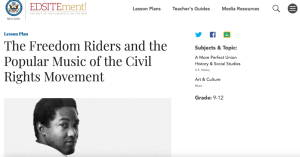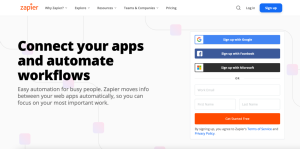Theme: Music and the Movement
Back to Top
|
 |
|
Virtual Nonprofit Tour of the Memphis Rock 'n' Soul Museum
|
Arts |
|
The Memphis Rock 'n' Soul Museum, a project of the Smithsonian Institute, curates exhibitions on soul music and social change. The museum "tells the story of musical pioneers who, for the love of music, overcame racial and socio-economic barriers to create the music that shook the entire world." At the link above, readers can enjoy a virtual tour of the museum led by Executive Director John Doyle. Along the way, Doyle emphasizes that Rock 'n' Soul is not just a music museum, but it is equally a civil rights museum. In particular, the museum explores how musicians in Memphis came together to fight segregation. Doyle's virtual walking tour of the museum makes several stops to describe exhibition items including outfits, musical instruments, handwritten lyrics, and audio equipment. Doyle concludes the tour by commenting that the museum provides resources for educators, too, which are freely available on the museum's website (linked in the video description). This virtual tour is made possible by cityCURRENT, a philanthropic catalyst in Tennessee looking to "power the GOOD." [EMB] |
|





|
|
 |
|
Civil Rights on the B-Side
|
Arts |
|
The Kennedy Center's series Of Thee We Sing explores how music shaped the early years of the Civil Rights Movement. In this 15-minute clip, host Jean Cochran describes a trove of civil rights music just recently discovered on the "B-side" of records. Cochran gets insights from a distinguished panel of guests: Dr. Dwandalyn Reece (curator of music and performing arts at the Smithsonian National Museum of African-American History and Culture), Robert Marovich (Founder and Editor-in-Chief of the Journal of Gospel Music), Dr. Robert Darden (a professor focusing on communications arts at Baylor University), and Dr. Birgitta Johnson (a professor in the School of Music at the University of South Carolina). These guests answer the question, why did artists record music on the "B-side" of records? In part, artists were protecting themselves from the threats that accompanied speaking up and singing loud about civil rights issues. The "B-side" served as a secret vessel for artists to bring fans their movement music as a "special message." Below the episode audio and transcript, readers will find two additional resources. The first is a link to the gospel song "Where Is Freedom," performed by the Friendly Four. The second, Civil Rights and the 1950s: Crash Course US History, explores some of the early work of the Civil Rights Movement, specifically looking at school segregation, bus boycotts, and the formation of the Southern Christian Leadership Conference. [EMB] |
|





|
|
 |
|
Civil Rights: The Music and the Movement
|
Arts |
|
This resource is perfect for those looking to learn more about the connections between music and the Civil Rights Movement. The hour-long panel was organized by The Forum@MC, a project of UC Davis's Mondavi Center, in 2009. It features a conversation between Jeffrey Callison (Capital Public Radio, KXJZ, Sacramento), Dr. Milmon Harrison (Professor and Director of the African American and African Studies program at the University of California-Davis), and Mavis Staples (gospel singer and civil rights activist). Staples, a member of the renowned gospel group The Staple Singers, shares stories from her involvement in the Civil Rights Movement and also reflects on the role of music in the movement generally. In her words, "the songs were stories ... the soundtrack of the movement." In addition to serious conversation about justice, equality, and perseverance, listeners will get the inside scoop on why the Staples family dropped the "s" to become The Staple Singers. [EMB] |
|





|
|
 |
|
The Freedom Riders and the Popular Music of the Civil Rights Movement
|
Arts |
|
High school history educators may enjoy this lesson plan from EDSITEment!, a humanities education hub that was featured in its entirety in the 07-15-2011 Scout Report. This lesson plan, which focuses on Music and the Civil Rights Movement, recognizes that "the popular music of the early 1960s offers a unique and engaging entry point into the politics surrounding equal rights in mid-twentieth century America." The lesson draws connections between pop culture and activism and explores music's special capacity as a platform for social change, analyzing the work of Nina Simone, Mahalia Jackson, and Sam Cooke, and many other artists. The curriculum includes six different activities, some of which rely on multimedia from other reputable sources such as PBS and the Smithsonian. Educators are provided with guiding questions, worksheets, and applicable web resources. The bottom of the page even highlights related EDSITEment! lesson plans, including "The Music of African American History" and "JFK, Freedom Riders, and the Civil Rights Movement." [EMB] |
|





|
|
 |
|
A Playlist for the Movement
|
Social studies |
|
This hour and a half episode of Teaching Hard History, a podcast produced by Teaching Tolerance, features host Dr. Hasan Kwame Jeffries (Associate Professor of History at The Ohio State University) in conversation with Dr. Charles L. Hughes (a historian, author, and the Director of the Lynne and Henry Turley Memphis Center at Rhodes College). The pair reflects on how music serves as a narrative device to better understand social movements, especially in the context of the Civil Rights Movement, where activists relied on anthems to inspire and engage crowds and build resilience throughout a hard-fought struggle for equality. Hughes notes that songs like "We Shall Overcome" became anthems for meetings and protests, providing organizers an outlet to build up morale and to communicate their message to other onlookers. Another popular song from this period is James Brown's "Say It Loud (I'm Black and I'm Proud)," which Hughes considers "a product of the civil rights and Black power era," because the fact that radio stations were willing to play an anthem that called out anti-Blackness and called for Black empowerment was itself a win of the movement. Jeffries and Hughes also explore unique aspects of "freedom songs," including their call-and-response style, which is responsive to the input of the audience. Towards the end of their discussion, they also discuss more recent songs, including Beyonce and Kendrick Lamar's track "Freedom," which they consider a piece of modern-era politically conscious music reminiscent of the work of the artists' predecessors Aretha Franklin, Sam Cooke, the Staples Singers, and Nina Simone. They also end with a reflection on music's unique value in educational settings, noting that "music is one of the few points of entry into the lives of our students that we actually get." [EMB] |
|





|
|



















